The Muscle Stimulator Market is estimated to be valued at USD 817.5 million in 2025 and is projected to reach USD 1210.1 million by 2035, registering a compound annual growth rate (CAGR) of 4.0% over the forecast period.
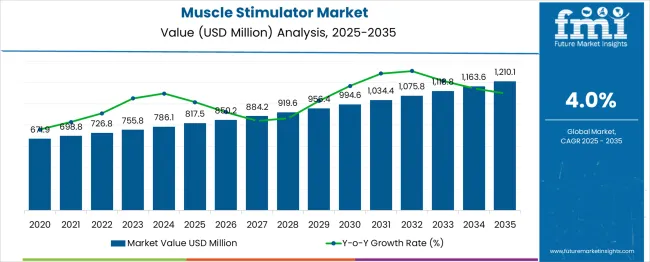
The muscle stimulator market is undergoing consistent growth as advancements in electrotherapy, rising awareness about non-invasive treatments, and increasing incidences of musculoskeletal disorders converge to drive adoption. Demand for muscle stimulators is being fueled by the preference for drug-free pain management solutions, growing penetration of home healthcare devices, and innovation in wearable technologies that make therapy more accessible and efficient.
Healthcare providers and consumers alike are recognizing the benefits of electrical stimulation in improving rehabilitation outcomes, enhancing muscle strength, and accelerating recovery. Future market expansion is expected to be supported by ongoing technological refinements, wider insurance coverage in certain geographies, and the integration of smart features enabling data tracking and personalized therapies.
Opportunities are emerging as stakeholders invest in portable, connected, and multi-application devices, setting the stage for sustained growth and deeper market penetration.
The market is segmented by Product, Modality, Application, and End User and region. Regionally, the market is classified into North America, Latin America, Western Europe, Eastern Europe, Balkan & Baltic Countries, Russia & Belarus, Central Asia, East Asia, South Asia & Pacific, and the Middle East & Africa.
When segmented by product, transcutaneous electrical nerve stimulation is anticipated to hold 27.5% of the total market revenue in 2025, establishing itself as the leading product category. This leadership is being reinforced by the growing adoption of non-invasive devices for pain relief, which align with the demand for alternatives to pharmacological treatments.
The ability of this product type to provide targeted, adjustable stimulation without requiring clinical supervision has encouraged usage both in medical facilities and home settings. Manufacturers have capitalized on its simplicity and affordability, expanding its reach across a broad patient base.
Its versatility in addressing a range of conditions from chronic pain to postoperative recovery has further strengthened its position as the preferred product category.
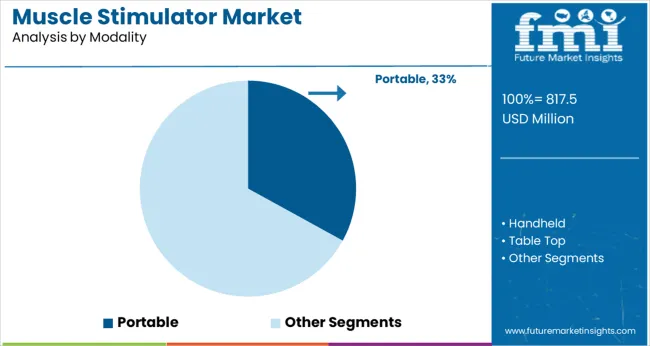
Segmented by modality, portable devices are projected to capture 33.0% of the market revenue in 2025, maintaining their leadership among modalities. The dominance of portable devices is being driven by consumer preference for convenient and discreet solutions that support at-home and on-the-go therapy.
Their compact form factor and ease of use have allowed patients to adhere more consistently to prescribed regimens, enhancing outcomes and satisfaction. Companies have responded by incorporating features such as rechargeable batteries, wireless operation, and intuitive interfaces, which have increased user confidence and broadened appeal.
This segment’s growth has also been supported by rising demand in outpatient care settings and among athletes seeking effective and mobile recovery tools, reinforcing its top position.
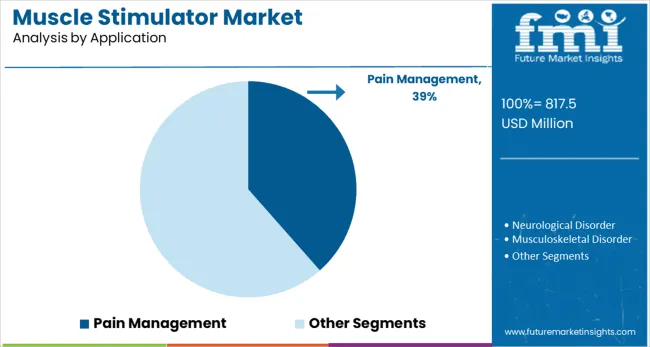
When segmented by application, pain management is expected to account for 38.5% of the market revenue in 2025, confirming its role as the leading application segment. This prominence is being driven by the increasing prevalence of chronic pain conditions and heightened awareness of the risks associated with opioid-based treatments.
Muscle stimulators have been embraced as an effective, non-addictive solution for managing pain across diverse patient populations. Their widespread adoption has been further supported by healthcare professionals recommending them as adjunct therapy in clinical pathways for arthritis, back pain, and post-surgical recovery.
The ability to offer immediate relief, enhance functional mobility, and reduce reliance on medications has solidified pain management as the primary driver of demand in this market.
Physiotherapists' demand for muscle stimulators significantly boosts market expansion. As they take up less time and are more effective, physiotherapists are increasingly choosing to employ muscle stimulation instead of manual approaches when treating patients in hospitals and at home. Additionally, incidences of anterior cruciate ligament (ACL) tears, hip flexor strains, and hamstring stress are also anticipated to increase growth.
In addition, factors like unhealthy diets and a lack of physical activity among the populace cause musculoskeletal disorders, which spur market expansion. As the aging population is more at risk and their numbers are growing rapidly, the frequency of such disorders will rise resulting in higher adoption of muscle stimulators which will drive the market in the future.
Transcutaneous electrical nerve stimulation is one of the most used forms of muscle stimulation for pain management. It provides brief relief. Without having any negative side effects, muscle stimulation can be used to treat a variety of ailments, such as back pain. Over the course of the projected period, the market will probably grow greatly as a result of these variables.
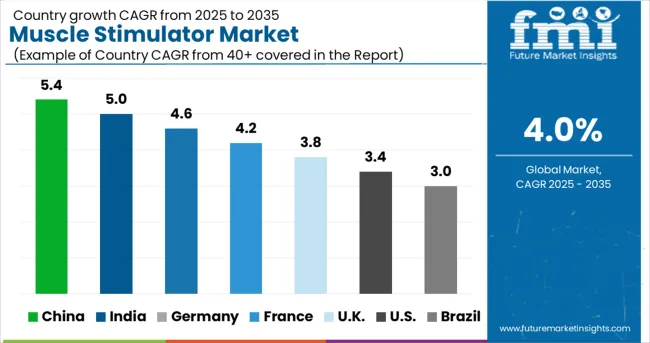
North America has the greatest share in the muscle stimulator market and makes the most contribution. Due to the high purchasing power of consumers and increased adoption of advanced and effective muscle stimulators.
Europe is predicted to have a significant share in the muscle stimulator market owing to the vast presence of the elderly population and well-established healthcare infrastructure.
During the forecast period, East Asia is expected to have the fastest growth rate. The two main factors driving the market are rising pain management therapy and rising awareness of health and fitness.
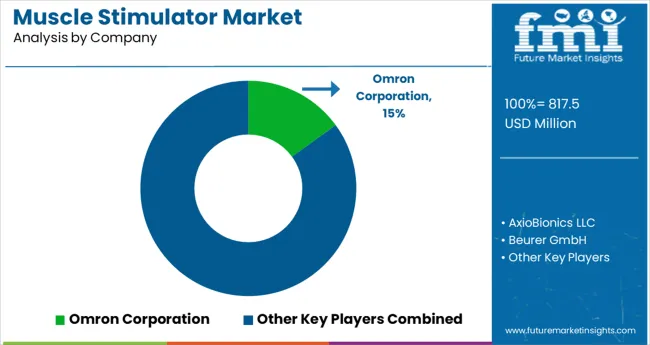
Enovis leverages Chattanooga’s entrenched distribution in physical therapy clinics, using its long rehabilitation line to anchor protocols and drive repeat device and consumable sales. Zynex has created a defensible billing-driven model: prescriber networks and DME reimbursement convert prescriptions into recurring electrode and accessory revenue. Omron pushes consumer adoption via retail and e-commerce, particularly in Asia and the U.S., while Beurer competes through broad OTC coverage and price positioning. BTL Industries stays clinic-centric, offering electrotherapy integrated into its wider physiotherapy suite, locking therapists into its ecosystem.
Regulation as a strategic weapon
Clinical and regulatory validation are actively used as competitive proof points. NeuroMetrix’s Quell secured FDA De Novo for fibromyalgia, a rare Rx-only claim in the category that positions it uniquely with payers and prescribers. Enovis/Chattanooga highlights cleared NMES/TENS indications across its recognized rehab portfolio, reinforcing legitimacy with professional buyers. BTL references broad current modes and past U.S. clearances to strengthen credibility in its combined therapy consoles. These approvals become central to sales decks, distributor training, and payer discussions, functioning as signaling tools to differentiate from low-cost OTC entrants.
Portfolio breadth and ecosystem lock-in
Competition is moving beyond single stimulators toward bundled ecosystems. Enovis pairs stimulation with complementary rehab hardware. Zynex ties patients into a stream of disposables and monitoring tools. BTL integrates electrotherapy into multi-modality platforms, making switching costly for clinics. Meanwhile, Beurer and Omron pursue consumer breadth scaling across wellness categories and creating household brand familiarity. This divergence ecosystem lock-in at the clinic tier, breadth and accessibility at the consumer tier is defining how leaders carve defensible positions in a market under pressure from commoditization.
| Report Attributes | Details |
|---|---|
| Growth Rate | CAGR of 4.0% from 2025 to 2035 |
| Base Year for Estimation | 2024 |
| Historical Data | 2012 to 2024 |
| Forecast Period | 2025 to 2035 |
| Qualitative Units | Revenue in USD Billion, Volume in Units, and CAGR from 2025 to 2035 |
| Report Coverage | Revenue Forecast, Company Ranking, Competitive Landscape, Growth Factors, Trends, and Pricing Analysis |
| Segment Covered | Product, Modality, Application, End User, Region |
| Region Covered | North America; Latin America; Europe; East Asia; South Asia; Oceania; Middle East & Africa |
| Key Countries Profiled | USA, Canada, Brazil, Mexico, Germany, UK, France, Spain, Italy, China, Japan, South Korea, Malaysia, Singapore, Australia, New Zealand, GCC Countries, South Africa, Israel |
| Key Players | AxioBionics LLC; Beurer GmbH; BioMedical Life Systems Inc.; Colfax Corporation; EMS Physio Ltd.; Liberate Medical; OMRON Corporation; RS Medical; Zynex Medical; Abbott; Medtronic; Cyberonics |
| Customization | Available Upon Request |
The global muscle stimulator market is estimated to be valued at USD 817.5 USD million in 2025.
It is projected to reach USD 1,210.1 USD million by 2035.
The market is expected to grow at a 4.0% CAGR between 2025 and 2035.
The key product types are .
portable segment is expected to dominate with a 33.0% industry share in 2025.






Full Research Suite comprises of:
Market outlook & trends analysis
Interviews & case studies
Strategic recommendations
Vendor profiles & capabilities analysis
5-year forecasts
8 regions and 60+ country-level data splits
Market segment data splits
12 months of continuous data updates
DELIVERED AS:
PDF EXCEL ONLINE
Muscle Relaxing Creams Market Size and Share Forecast Outlook 2025 to 2035
Muscle Oxygen Monitors Market Size and Share Forecast Outlook 2025 to 2035
Muscle Relaxant Drugs Market Size and Share Forecast Outlook 2025 to 2035
Muscle Tension Dysphonia Treatment Market - Trends, Growth & Forecast 2025 to 2035
The Muscle Stimulation Devices Market is segmented by Product, Application and End User from 2025 to 2035
Fish Muscle Protein Market Analysis by Species, Type, Form and Application Through 2035
Bowel Stimulators Market Growth – Trends, Demand & Forecast 2024-2034
SPG Microstimulator System Market
Deep Brain Stimulator Market Size and Share Forecast Outlook 2025 to 2035
Spinal Cord Stimulators Market Growth - Trends & Forecast 2025 to 2035
Bone Growth Stimulators Market is segmented by product type, application and end user from 2025 to 2035
Vagus Nerve Stimulator Market Analysis – Growth & Industry Insights 2018-2026
Pelvic Floor Stimulators Market – Trends & Forecast 2025 to 2035
Nerve Locator Stimulator Market
Gastric Electrical Stimulators Market Growth - Trends & Forecast 2025 to 2035
Percutaneous Electrical Nerve Stimulators Market Analysis - Size, Share, and Forecast Outlook 2025 to 2035
Electromyographic Rehabilitation Stimulator Market Size and Share Forecast Outlook 2025 to 2035

Thank you!
You will receive an email from our Business Development Manager. Please be sure to check your SPAM/JUNK folder too.
Chat With
MaRIA